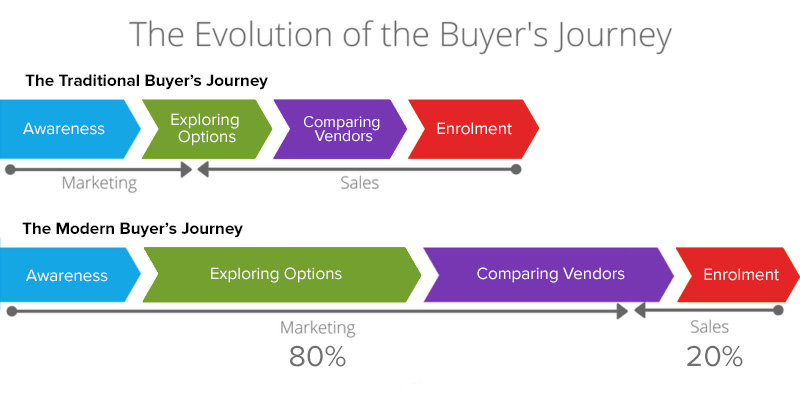When done right, content marketing is a powerful way to drive leads and sales revenue. In the same vein, our industry experience shows us that content that is truly helpful and answers consumer questions, is the same content that sells. However, creating and publishing content without a clear strategy can be like shooting in the dark: you may hit the target once in a while, but you may miss the mark most of the time. That’s why having a content marketing strategy is crucial for achieving your business goals. In this article, we’ll show you how to create a content marketing strategy that drives traffic, leads and sales and helps you connect with your target audience in a meaningful and measurable way.
In particular, we’re going to cover:
Why ‘trust’ is the secret ingredient to a successful content marketing strategy
Trust is a fickle thing. It’s embedded in all aspects of our lives. In our friendships, in our romantic relationships, in our family life, and with our pets. That’s right. With our pets. If you have a cute giant puppy like I do (or a cute little one), then you are trusting them every single time you pat your puppy. You’re trusting him or her not to bite your hand off. You have trust because there’s been enough interactions between yourself and your puppy that you know, no matter what, your fur baby will never bite you.
This same trust which guides your hand when you pat your pet is also the same trust that acts as the driving force which guides the buying decision.
People buy because they want to receive something from you, and the emotion which guides this exchange and allows it to flow is trust. In order to receive A in exchange for B, I must trust that you will fulfil your promise on giving me A when I give you B. This principle of trust is eternal and will always be integrated in sales, marketing, and business, not to mention our personal lives. If we are all in the business of something, it is trust.
We should therefore be asking ourselves in every instance where our brand interacts with our prospect, ‘If we do this, will this lead to increasing trust with our customer?’
The modern buyer is more informed, more sceptical, and more empowered than ever before. To capture their attention and win their business, companies must first establish trust with their buyer. With the internet now being the predominant point of research for most buyers, there is less of a reliance on the sales or customer service department of a business. The majority of buyers make a decision about what they’re going to buy before they even talk to a salesperson.
Did you know that on average, today’s buyer has already made 80% of the buying decision BEFORE the first sales call?
Marcus Sheridan, Author of They Ask, You Answer

This is where the ‘They Ask, You Answer’ (TAYA) framework comes in. TAYA is a business and marketing framework that focuses on answering the questions and concerns of your target audience, even the difficult or uncomfortable ones. By being transparent and informative, TAYA helps build trust with potential customers, positioning your brand as a thought leader in your industry.
In the next section, we’ll dive deeper into what TAYA is and what it looks like in practice.
What is TAYA?
They Ask You Answer is a practical framework and sales and marketing philosophy that assumes one simple truth: if your prospect or customer asks a question, you answer, and in doing so, you will become the most trusted voice in your space and will gain more business than you ever have before.
What does TAYA look like in practice?
TAYA in practice looks like this:
- Alignment between your sales and marketing teams
- Regular content brainstorming sessions with sales driving content ideas
- Three blog articles published every week
- The use of content in the sales process (aka Assignment Selling)
Alignment between your sales and marketing teams
One of the core aspects of TAYA is forming a Revenue Team.
A Revenue Team is a combination of your sales and marketing teams and is made up of key players from both sales and marketing. All activities, regardless of individual roles, are focused on the shared goal of increasing company revenue.
Research has found that when marketing and sales are aligned, there are exceptional benefits, including higher sales close rates, increased revenue, and increased retention rates.
In particular, some of the benefits include:
- Attracts higher quality leads
- Saves your sales rep time as they use content to answer commonly asked questions
- Increased sales and shorter sales cycle
- Better alignment leads to less employee churn and happier teams
- Visibility around which content produces ROI
Regular content brainstorming sessions
When your marketing and sales teams are aligned, one of the core benefits is content creation under the influence of sales.
Typically, marketing sit in their ivory towers creating content that they think will be beneficial for their target audience, but the problem is that content they think will be beneficial is usually not content that answers buyers most pressing questions. On the other hand, salespeople are on the front line everyday, answering buyer questions. The point here, is that salespeople are better placed to formulate content ideas to answer buyer questions than marketing. Usually though, there is a lack of alignment between marketing and sales which prevents this from happening.
However, with the formation of a Revenue Team, regular content brainstorming sessions ensure that relevant content is created for buyers.
Three blog articles published every week
Core to TAYA is the principle of writing and publishing three blog articles on our website every week. There’s a myriad of reasons to publish three articles on your website every week, but ultimately, this is one of the most crucial steps of the TAYA framework.
The use of content in the sales process
Assignment Selling is when we assign “homework” to prospects in the form of educational blog articles or videos. Using Assignment Selling increases close rates and shortens the sale lifecycle.
When we implement TAYA, we don’t just produce three articles every week, we also actively use these articles in our 1:1 sales emails as Assignment Selling pieces.

And there you have it, that’s what TAYA looks like in practice.
How to Implement a Content Strategy
To implement a content strategy, we need to follow five steps:
- Forming a revenue team
- Conducting regular content brainstorms
- Writing three articles every week
- Scaling to produce 50+ content pieces every week
- Continuous improvement and optimisation
Forming a Revenue Team
Forming a revenue team requires collaboration between the marketing and sales departments. In order to form a Revenue Team and adopt best practices, you need to do the following:
- Getting alignment between your sales and marketing leaders is probably the single most important step in successfully forming a Revenue Team. To get alignment, you need to get buy-in from your leadership. In other words, your team needs to be bought into the vision behind a Revenue Team, otherwise it’s just not going to work.
- Establish regular content brainstorms at the same time every fortnight or month.
- Assignment Selling needs to be adopted by your sales team. If your sales team doesn’t utilise the articles that marketing produces, it’d be pointless to form a Revenue Team.
- Get measurement frameworks in place so that your marketing team can report on sales revenue generated from content.
Conducting regular content brainstorms
You already know you have to conduct regular content brainstorms, but how should you run a content brainstorm session?
As a starting point, the sales team will generally answer the following questions in a discussion format with the marketing team:
- What questions do you get asked that immediately indicate the buyer is not close to ready to make a decision?
- What do your clients and buyers push back on the most?
- What are your buyer’s biggest doubts or worries (with respect to the product, the process, the company)?
- What do your buyers have to convince the key decision-makers of?
Writing three articles every week
The marketing department should write, review, and publish three blog articles every week. To find out more about why and how you should go about doing this, check out our article on why you need to publish three blog articles every week.
Scaling to produce 50+ pieces of content per week
Once you’re running regular content brainstorming sessions and publishing three articles per week, it’s time to scale things up. How can you do this?

As you can see in the image above, our formula consists of three stages.
- We create pieces of long form content (2 podcast episodes and 3 blog articles).
- We repurpose each podcast episode into 5 smaller video snippets, and two of the blog articles into video scripts for short videos.
- Then, we post the podcast episodes and podcast small clips across 4 different social platforms.
With the addition of fortnightly e-newsletters and more, we produce and distribute more than 65 pieces of content per week.
Being completely transparent with you, this number changes every week for us, depending on our objectives, however, it never falls far too short of 65 pieces of content. Regardless, we know that we’re always going to be producing and distributing content, every single week.
The key to this strategy is picking what long form piece of content you will create, and then finding a smart and efficient way to transform this into multiple smaller pieces of content, and then distributing all of this across your social channels.
You might not end up with 65 pieces of content per week. But, if you follow this framework, you’ll end up with more content than you know what to do with. And that’s a good problem to have.
To recap, building out your content marketing strategy involves four key steps:
- Forming a revenue team
- Conducting regular content brainstorms
- Writing three articles every week
- Scaling to produce 50+ content pieces every week
Continuous Improvement and Optimisation
Creating a content marketing strategy is not a one-time event. It requires continuous improvement and optimization to achieve the desired results. Data analysis and insights are crucial for identifying what works and what doesn’t, as well as understanding what your audience wants to see.
One way to continuously improve your content marketing strategy is to regularly review your data and identify any areas that need improvement. This can be done using various tools and metrics, such as page views, bounce rates, click-through rates, and engagement rates.
Most importantly, it’s essential to have a proper data setup in place for your business. You should be using a CRM to capture marketing and sales data all in one platform. Regardless of what you choose, you need to make sure that you have measurement frameworks in place so that you can view metrics around your content.
Here’s a tip: if you don’t know exactly how much revenue any single one of your blog articles are generating, then you probably don’t have the correct measurement frameworks in place.

Want to improve your measurement framework? Check out this article.
The One Thing You Need to Remember
In order to create a content strategy, you need to focus on:
- Forming a revenue team
- Conducting regular content brainstorms
- Writing three articles every week
- Scaling to produce 50+ content pieces every week
- Continuous improvement and optimisation
Core to a successful content marketing strategy is facilitating trust and implementing TAYA. Have more questions or want help developing a content marketing strategy?
Then you might want to find out the difference between building out your content marketing strategy with a typical digital marketing retainer vs working with a coach and doing it yourself.












